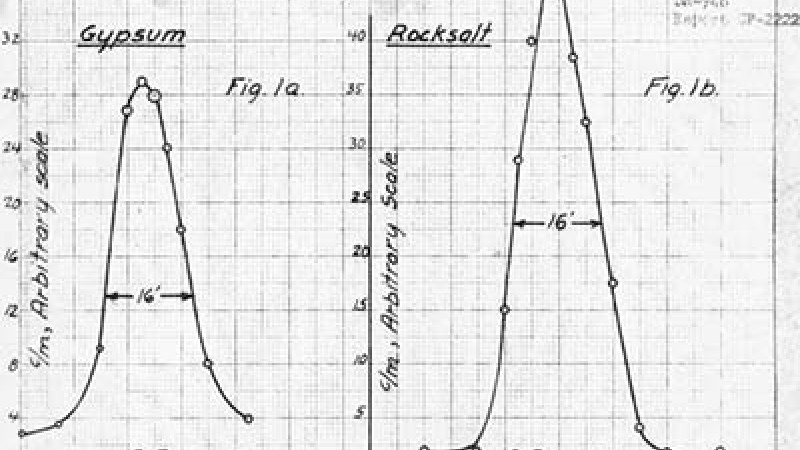“A very useful and simple physical tool” is how physicist Ernest O. Wollan described neutron scattering, after first observing neutron diffraction at the X-10 graphite reactor and then performing some early experiments at what was then Clinton Laboratories, now The early development of neutron diffraction: science in the wings of the Manhattan Project” relates the story of how researchers in the United States, working at locations that eventually became ANL and ORNL, laid the groundwork for the new field of neutron diffraction. The story began nearly 30 years earlier when Sir William Henry Bragg and his son Sir William Lawrence Bragg used x-ray diffraction to elucidate the atomic structure of crystals. Their discovery and the formulation of Bragg’s law earned them the 1915 Nobel Prize in Physics.
Here at ORNL, the graphite-moderated X-10 pile (later known as the Oak Ridge Graphite Reactor) began operation at Clinton Laboratories on November 4, 1943. The following year, a heavy-water reactor, CP‑3, started up at what would become ANL, near Chicago. The new piles made slow neutrons available in large enough numbers for more fundamental explorations of matter. In 1944 this allowed the American researchers to experimentally verify that neutrons could be diffracted by a crystal to produce set of sharp and intense peaks known as “Bragg peaks.” The positions and intensities of Bragg peaks provide the key to the atomic structure of a crystalline material.
Following the end of the second world war, Wollan was joined at ORNL by Clifford Shull, and together over the next several years they and their colleagues greatly advanced the method of neutron diffraction. In reference to X-10 and CP-3, Shull would later remark that “both of these neutron sources were used through the war-time period for obtaining critically needed physical and technical data of interest to the Manhattan Project. Among these activities was the use of single-axis spectrometers and Fermi-type choppers for selecting monoenergetic beams of slow neutrons for cross-section work.”
By 1949, Alvin Weinberg, another early ORNL pioneer, could definitively say that neutron diffraction “has become an extraordinarily powerful tool for the investigation of the structure of hydrogen-containing crystals.” With remarkable prescience, Weinberg went on: “The use of neutron diffraction for the systematic study of crystals and molecular structure is apt to remain a most important basic scientific function of the national laboratories.”
None of the early pioneers could have anticipated the profound impact of neutron diffraction studies. Measurements first with powder samples and subsequently with single crystals established that the crystal structure of ice obeyed the rules proposed earlier by the American chemist Linus Pauling and definitively ruled out several competing theories. In the early 1960s, the United Kingdom Antarctic Place-names Committee assigned the names of researchers who determined the structure of ice crystals to several features in Antarctica’s Crystal Sound, including the Bragg Islands, the Pauling Islands, Levy Island (named for ORNL crystallographer Henri Levy), Wollan Island, and Shull Rocks.
The work impacted other scientific fields as well. The first neutron diffraction measurement of antiferromagnetic Bragg peaks came as a complete surprise. The discovery was instrumental in leading to the concept of “broken symmetry” that is important in cosmology and particle physics, as well as condensed matter physics.
In 1994, Shull shared the Nobel Prize in Physics with Canadian Bertram N. Brockhouse for his early contribution to neutron science. Shull was recognized specifically “for the development of the neutron diffraction technique,” and he concluded his Nobel lecture with a tribute to “the association, collaboration, and close friendship” that he enjoyed with Wollan, who had died 10 years earlier.
Mason writes that in the years following the pioneering work described in the article “advances in the use of neutrons as a probe of materials have followed not only from increases in reactor power but also from the refinement of instruments and techniques. The addition of accelerator-based neutron sources such as the Spallation Neutron Source at ORNL to the nuclear reactors has taken neutron diffraction to a new level.”
Today's neutron scattering facilities at ORNL are funded by the Scientific User Facilities Division, Office of Basic Energy Sciences, US Department of Energy.
Publication
T. E. Mason, T. J. Gawne, S. E. Nagler, M. B. Nestor, and J. Carpenter, “The early development of neutron diffraction: science in the wings of the Manhattan Project,” Acta Crystallography A 69(1), 37–44 (2013),



